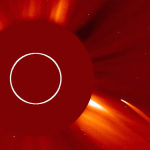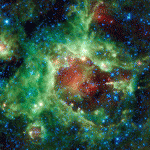
Could we ever get home from a super-Earth?
It’s hard enough for huge rockets to provide the energy required to launch into orbit from Earth. But what if the field of gravity was even more intense – such as on one of the promising exoplanets known as ‘super-Earths’?
Huge rocket required
If we landed on the Kepler-20b super-Earth and wanted to build a rocket to get home using the same propulsion systems as the Saturn V rocket that sent man to the Moon, it would have to be more than 500 metres tall and weigh the same as the Great Pyramid of Giza.
The greater the mass of a planet, the more difficult it becomes to launch a rocket from the surface into space. In practice this means that the payload a rocket can lift into space is reduced with greater planet mass.
Earth has a mass of 5.97 x 1031 tonnes, and the SpaceX Falcon Heavy rocket can lift some 50,000kg into an orbit around our planet. If Falcon Heavy took off from Kepler-20b, a ‘super-Earth’ which has a mass almost 10 times that of Earth, then the rocket would be able to lift only 40kg into orbit, less than a thousandth of the payload on Earth.
So even though aerospace activities are possible on a planet such as Kepler-20b, they would be unrealistic with the rocket technology that is available today.
Good to visit, hard to leave
Super-Earths, which have a mass and radius bigger than Earth’s but smaller than large planets such as Uranus and Neptune, are interesting because they are frequent in other solar systems and probably offer the best chances of finding life in space. The size of the planets means that they probably have an iron core that produces a protective magnetic field, while their masses are high enough that they have the necessary gravity to maintain an atmosphere and so a stable climate.
If aerospace activities with astronauts or heavy payloads is to be possible on a super-Earth such as Kepler-20b, we must develop a new engine technology that is more complex and powerful than the engines used now.
One option might be to incorporate a series of nuclear bombs that explode quickly one after the other behind the rocket. That would provide the necessary engine power, but also risk spreading radioactive waste over large regions were a launch were to go wrong.

Earth
Diameter: 12,740 km
Mass: 5.97 × 1021 tonnes
Minimum speed of rocket: 11.2 km/second
The Saturn V that brought man to the Moon was 111 metres tall and weighed 2970 tonnes.
Kepler-20 b
Diameter: 23,800 km
Mass: 5.8 × 1022 tonnes
Minimum speed of rocket: 27.1 km/second
A rocket with a lifting power corresponding to that of Saturn V would have to be 569 metres tall and weigh 400,000 tonnes.
[Image: Shutterstock]






